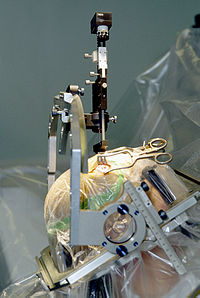
Photo from wikipedia
Objective: To quantify procedure-level inappropriate antimicrobial prophylaxis utilization as a strategy to identify high-priority targets for stewardship efforts in pediatric surgery. Background: Little data exist to guide the prioritization of… Click to show full abstract
Objective: To quantify procedure-level inappropriate antimicrobial prophylaxis utilization as a strategy to identify high-priority targets for stewardship efforts in pediatric surgery. Background: Little data exist to guide the prioritization of antibiotic stewardship efforts as they relate to prophylaxis utilization in pediatric surgery. Methods: This was a retrospective cohort analysis of children undergoing elective surgical procedures at 52 children’s hospitals from October 2015 to December 2019 using the Pediatric Health Information System database. Procedure-level compliance with consensus guidelines for prophylaxis utilization was assessed for indication, antimicrobial spectrum, and duration. The relative contribution of each procedure to the overall burden of noncompliant cases was calculated to establish a prioritization framework for stewardship efforts. Results: A total of 56,845 cases were included with an overall inappropriate utilization rate of 56%. The most common reason for noncompliance was unindicated utilization (43%), followed by prolonged duration (32%) and use of excessively broad-spectrum agents (25%). Procedures with the greatest relative contribution to noncompliant cases included cholecystectomy and repair of inguinal and umbilical hernias for unindicated utilization (63.2% of all cases); small bowel resections, gastrostomy, and colorectal procedures for use of excessively broad-spectrum agents (70.1%) and pectus excavatum repair and procedures involving the small and large bowel for prolonged duration (57.6%). More than half of all noncompliant cases were associated with 5 procedures (cholecystectomy, small bowel procedures, inguinal hernia repair, gastrostomy, and pectus excavatum). Conclusions: Cholecystectomy, inguinal hernia repair, and procedures involving the small and large bowel should be considered high-priority targets for antimicrobial stewardship efforts in pediatric surgery.
Journal Title: Annals of surgery
Year Published: 2022
Link to full text (if available)
Share on Social Media: Sign Up to like & get
recommendations!